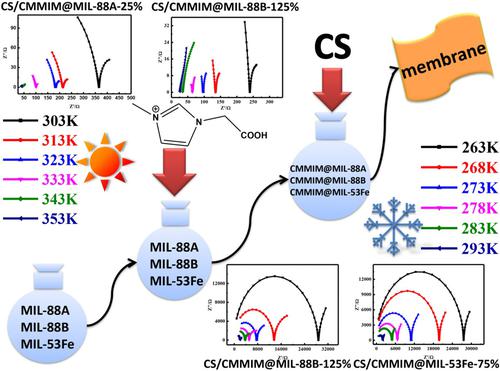当前位置:
X-MOL 学术
›
Appl. Organomet. Chem.
›
论文详情
Our official English website, www.x-mol.net, welcomes your
feedback! (Note: you will need to create a separate account there.)
Proton conductivity study on three CS/IL@fle‐MOF membranes
Applied Organometallic Chemistry ( IF 3.7 ) Pub Date : 2020-09-01 , DOI: 10.1002/aoc.5981 Xiaofeng Zheng 1 , Xinyu Zhao 1 , Jie Huang 2 , Hao Yang 1 , Qinghui Wang 1 , Yuhang Liu 1 , Peiwei Gong 1 , Laijin Tian 1 , Hongping Xiao 3 , Zhe Liu 1
Applied Organometallic Chemistry ( IF 3.7 ) Pub Date : 2020-09-01 , DOI: 10.1002/aoc.5981 Xiaofeng Zheng 1 , Xinyu Zhao 1 , Jie Huang 2 , Hao Yang 1 , Qinghui Wang 1 , Yuhang Liu 1 , Peiwei Gong 1 , Laijin Tian 1 , Hongping Xiao 3 , Zhe Liu 1
Affiliation

|
The low‐cost, high specific surface area and porosity, controlled pore size, and chemical properties of metal–organic framework (MOF) materials have attracted much attention in the exploration of proton conduction. The method of chemically modifying MOF structures or introducing conductive medium into the holes can effectively improve the proton conductivities of the materials. Here, the structural tunability of ionic liquid (IL) and flexible MOF (fle‐MOF) materials are matched to give full play to the conductivity of IL, the framework support, and the microporous effect of MOFs, which achieves the synergistic effect of performance and expands the temperature range of proton transfer. Three kinds of CS/IL@fle‐MOF membranes were prepared by combining three fle‐MOFs with 1‐carboxymethyl‐3‐methylimidazole (CMMIM) in different proportions to obtain 15 pieces of membranes. The comparative analyses show that CS/IL@fle‐MOF membranes have excellent proton conduction performance at a wider temperature range (263–353 K) and lower relative humidity (75% RH). Among them, the proton conductivities of CS/CMMIM@MIL‐88A‐25% and CS/CMMIM@MIL‐88B‐125% are up to 1.33 and 1.42 S cm−1 at 75% RH and 353 K, respectively; whereas those of CS/CMMIM@MIL‐53(Fe)‐75% and CS/CMMIM@MIL‐88B‐125% reach up to 2.1 × 10−3 and 1.28 × 10−3 S cm−1 at 75% RH and 263 K, respectively. The Ea of CS/CMMIM@fle‐MOFs is in the range of 0.1–0.5 eV, suggesting that the proton transport follows predominantly the typical Grotthuss transfer mechanism. The results of this study indicate that the CS/CMMIM@fle‐MOF membranes combinations offer great potential for the design of composite porous proton‐conducting materials.
中文翻译:

三种CS / IL @ fle-MOF膜的质子传导率研究
金属-有机骨架(MOF)材料的低成本,高比表面积和孔隙率,可控制的孔径以及化学性质已在质子传导研究中引起了广泛关注。化学修饰MOF结构或将导电介质引入孔中的方法可以有效地提高材料的质子电导率。在这里,离子液体(IL)和柔性MOF(fle-MOF)材料的结构可调性相匹配,以充分发挥IL的电导率,骨架支撑和MOF的微孔效应,从而实现性能的协同效应并扩大了质子转移的温度范围。通过将三种fle-MOF与1-羧甲基-3-甲基咪唑(CMMIM)以不同的比例混合制成15种膜,从而制备了三种CS / IL @ fle-MOF膜。对比分析表明,CS / IL @ fle-MOF膜在较宽的温度范围(263-353 K)和相对湿度较低(75%RH)的情况下具有出色的质子传导性能。其中,CS / CMMIM @ MIL‐88A‐25%和CS / CMMIM @ MIL‐88B‐125%的质子电导率分别高达1.33和1.42 S cm-1在75%RH和353 K下; 而CS / CMMIM @ MIL‐53(Fe)‐75%和CS / CMMIM @ MIL‐88B‐125%的那些在75%RH和以下时达到2.1×10 -3和1.28×10 -3 S cm -1分别为263 K CS / CMMIM @ fle-MOF的E a在0.1–0.5 eV的范围内,这表明质子传输主要遵循典型的Grotthuss转移机制。这项研究的结果表明,CS / CMMIM @ fle-MOF膜的结合为复合多孔质子传导材料的设计提供了巨大的潜力。
更新日期:2020-11-06
中文翻译:

三种CS / IL @ fle-MOF膜的质子传导率研究
金属-有机骨架(MOF)材料的低成本,高比表面积和孔隙率,可控制的孔径以及化学性质已在质子传导研究中引起了广泛关注。化学修饰MOF结构或将导电介质引入孔中的方法可以有效地提高材料的质子电导率。在这里,离子液体(IL)和柔性MOF(fle-MOF)材料的结构可调性相匹配,以充分发挥IL的电导率,骨架支撑和MOF的微孔效应,从而实现性能的协同效应并扩大了质子转移的温度范围。通过将三种fle-MOF与1-羧甲基-3-甲基咪唑(CMMIM)以不同的比例混合制成15种膜,从而制备了三种CS / IL @ fle-MOF膜。对比分析表明,CS / IL @ fle-MOF膜在较宽的温度范围(263-353 K)和相对湿度较低(75%RH)的情况下具有出色的质子传导性能。其中,CS / CMMIM @ MIL‐88A‐25%和CS / CMMIM @ MIL‐88B‐125%的质子电导率分别高达1.33和1.42 S cm-1在75%RH和353 K下; 而CS / CMMIM @ MIL‐53(Fe)‐75%和CS / CMMIM @ MIL‐88B‐125%的那些在75%RH和以下时达到2.1×10 -3和1.28×10 -3 S cm -1分别为263 K CS / CMMIM @ fle-MOF的E a在0.1–0.5 eV的范围内,这表明质子传输主要遵循典型的Grotthuss转移机制。这项研究的结果表明,CS / CMMIM @ fle-MOF膜的结合为复合多孔质子传导材料的设计提供了巨大的潜力。











































 京公网安备 11010802027423号
京公网安备 11010802027423号